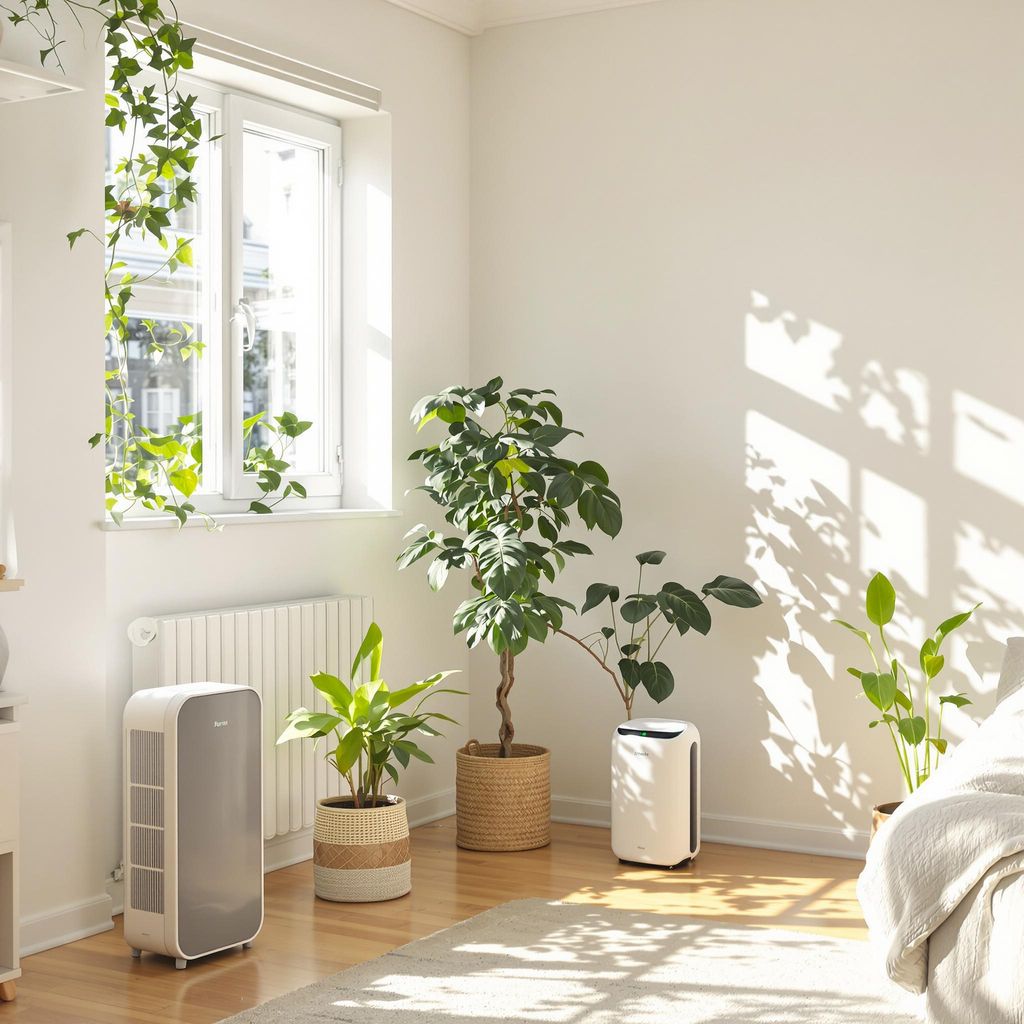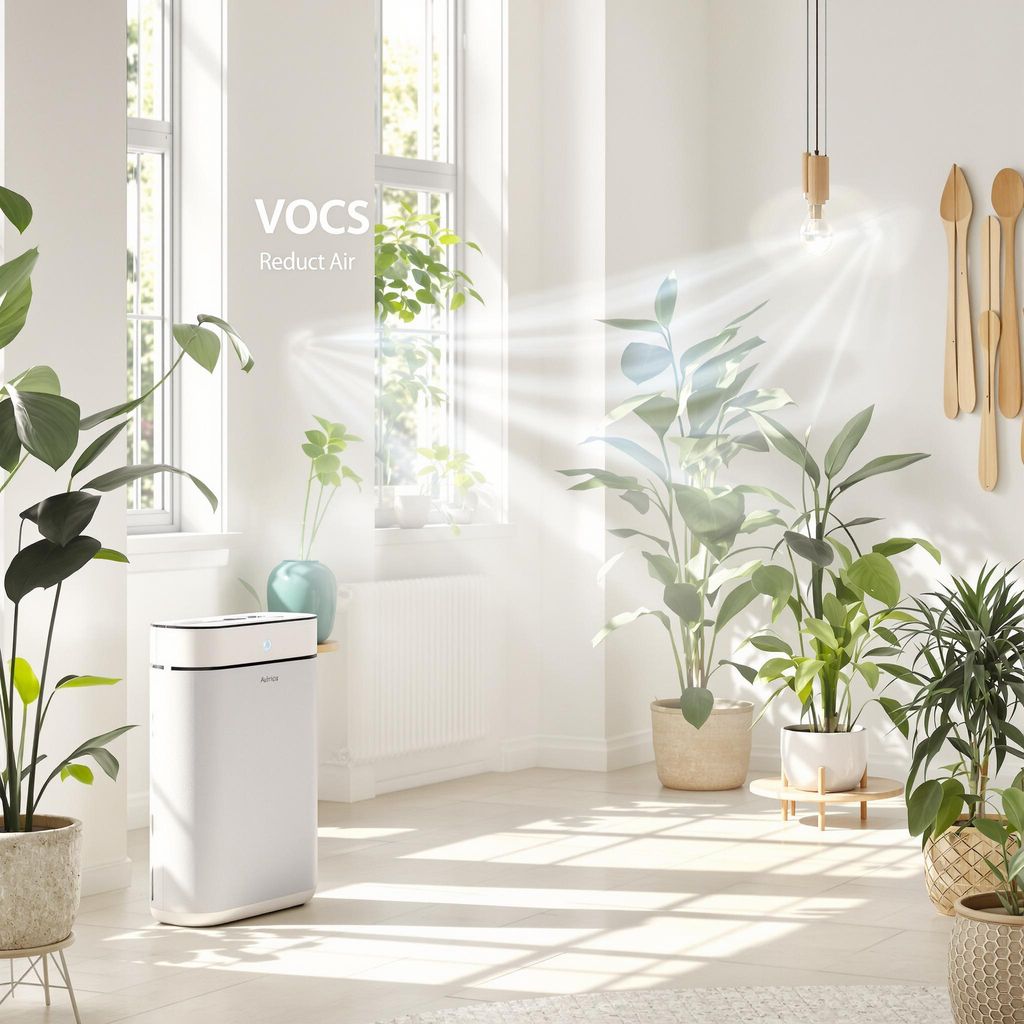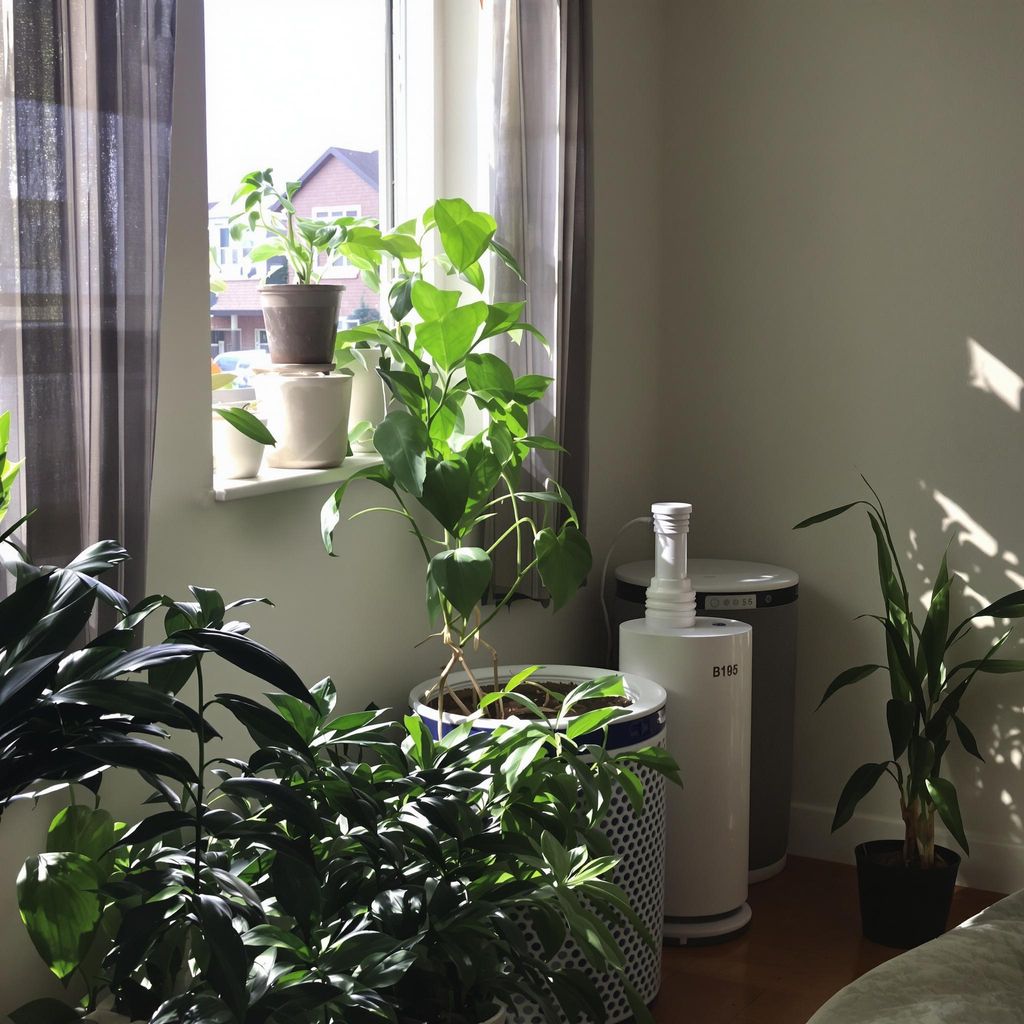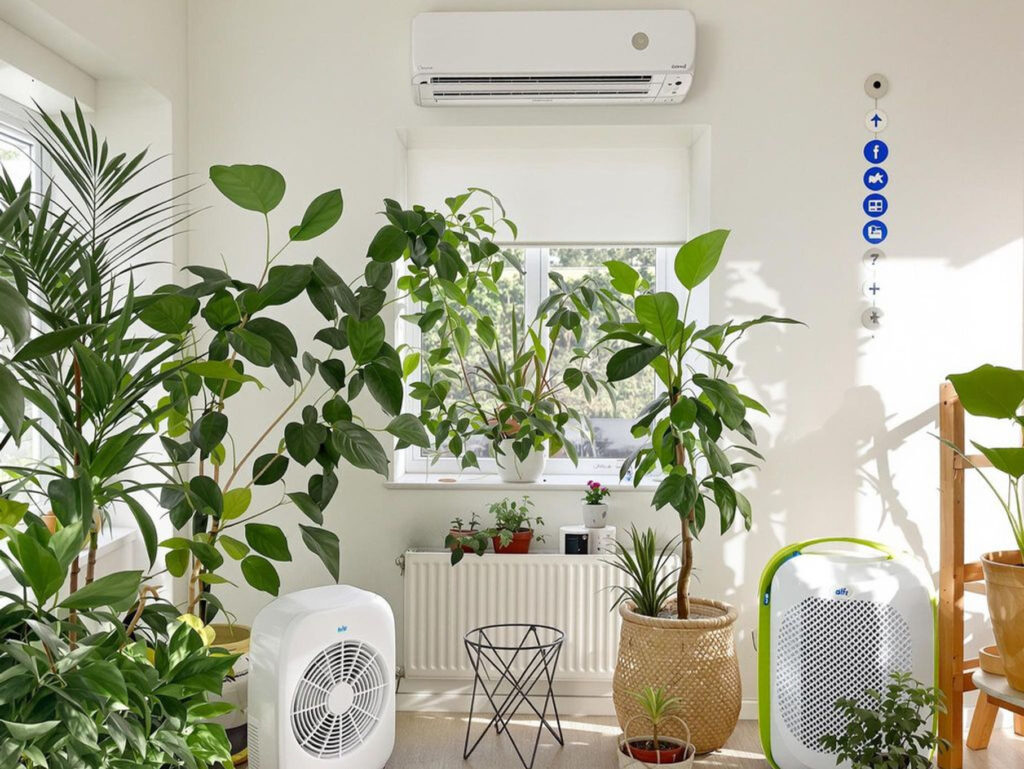Key Takeaways
-
Proper ventilation is essential to reduce indoor air pollutants and improve air circulation.
-
Pet grooming and creating pet-free zones can significantly cut down on allergens like dander.
-
Avoid smoking indoors to prevent harmful tobacco-related pollutants from lingering in your home.
-
Air purifiers can help filter out dust, pollen, and other contaminants, but they need regular maintenance.
-
Choosing low-VOC materials and keeping your living space clean can make a big difference in air quality.
Understanding Common Indoor Air Pollutants in Oak Park, IL

Sources of Indoor Air Pollution
Indoor air pollution can come from so many places, and a lot of them might surprise you. Everyday activities like cooking, cleaning, or even just walking around can release pollutants into your home. Here are some common sources:
-
Tobacco smoke: This one’s a biggie. Cigarettes, cigars, and pipes release thousands of chemicals, some of which are downright toxic.
-
Volatile Organic Compounds (VOCs): Found in paints, cleaning products, and even furniture, these chemicals can linger in the air for a long time.
-
Pet dander: If you’ve got pets, their skin flakes and fur can contribute to poor air quality.
-
Cooking fumes: Frying up your favorite dish? Those cooking oils and smoke can release fine particles into the air.
-
Outdoor pollutants: Things like pollen and dust can hitch a ride indoors on your clothes or through open windows.
Health Impacts of Poor Indoor Air Quality
Breathing in polluted air isn’t just annoying—it’s unhealthy. Poor indoor air quality can lead to a range of health issues, especially if you’re exposed to it over time. Here’s what you might notice:
-
Irritation of the eyes, nose, and throat.
-
Worsening of asthma or allergy symptoms.
-
Long-term exposure can even contribute to more serious issues like respiratory diseases or heart problems.
For kids, elderly folks, and those with pre-existing conditions, the risks are even higher. It’s not something to ignore.
Why Oak Park, IL Faces Unique Challenges
Oak Park’s charm is undeniable, but its location and older homes come with their own set of air quality hurdles. Here’s why:
-
The area’s proximity to Chicago means it can sometimes experience spillover from urban pollution.
-
Many homes in Oak Park are historic and might not have modern ventilation systems, making it easy for pollutants to build up.
-
Seasonal challenges like high pollen in spring and sealed-up houses in winter also play a role.
Living in Oak Park is wonderful, but staying proactive about indoor air quality is key. Simple steps like improving ventilation or using air purifiers can make a big difference.
The Role of Ventilation in Reducing Indoor Air Pollutants

Benefits of Proper Ventilation
Good ventilation is like giving your home a chance to breathe. Proper airflow helps flush out pollutants, such as dust, cooking fumes, and carbon dioxide, while bringing in fresh, clean air. Without it, these particles can stick around and build up, affecting your health and comfort. Plus, good ventilation reduces moisture, which means less chance for mold and mildew to grow.
How to Improve Ventilation in Your Home
Here are some practical ways to boost your home’s ventilation:
-
Open windows and doors whenever the weather allows. This is the simplest way to get fresh air circulating.
-
Use exhaust fans in your kitchen and bathrooms to remove steam, odors, and smoke.
-
Make sure your HVAC system is well-maintained. A clean filter can make a big difference in air quality.
-
Consider installing a whole-house ventilation system if your home feels stuffy or sealed tight.
Common Ventilation Mistakes to Avoid
Even with good intentions, people often make mistakes when it comes to ventilation:
-
Blocking vents with furniture or curtains can restrict airflow.
-
Forgetting to clean exhaust fans can reduce their efficiency over time.
-
Running fans without checking if they vent outside. Some just recirculate air, which doesn’t help much.
-
Leaving windows open during high-pollen days can bring allergens inside.
A well-ventilated home isn’t just more comfortable; it’s healthier. It’s worth taking the time to make sure your air is as clean as it can be.
Managing Pet-Related Indoor Air Pollutants
Reducing Pet Dander in Your Home
-
Vacuum carpets and furniture weekly with a vacuum equipped with a HEPA filter.
-
Wash pet bedding and blankets frequently to remove accumulated dander.
-
Consider using an air purifier specifically designed to capture allergens like pet dander.
Best Practices for Pet Grooming
Grooming your pets isn’t just about keeping them looking good—it also helps reduce the amount of dander they shed. Follow these tips:
-
Brush your pets regularly, preferably outdoors, to remove loose fur and dander.
-
Bathe your pets monthly or as recommended by your vet, using pet-safe shampoos that help reduce allergens.
-
Trim your pet’s nails and clean their paws to reduce dirt and allergens they might bring indoors.
Grooming sessions can also be a great bonding time with your pet while helping to maintain a cleaner home environment.
Creating Pet-Free Zones
Designating certain areas of your home as pet-free zones can significantly improve air quality in those spaces. For example:
-
Make bedrooms off-limits to pets to ensure you have a dander-free area for sleeping.
-
Use baby gates or closed doors to restrict pets from entering specific rooms.
-
Set up comfortable areas for your pets in well-ventilated spaces to keep them happy while maintaining cleaner air in other parts of your home.
By combining these strategies, you can enjoy the companionship of your furry friends without compromising on indoor air quality.
The Impact of Tobacco Smoke on Indoor Air Quality
Dangers of Secondhand Smoke
Tobacco smoke isn’t just a personal habit—it’s a major indoor air pollutant. Secondhand smoke contains over 7,000 chemicals, including at least 70 that are known to cause cancer. For non-smokers, exposure can lead to serious health problems like lung cancer, heart disease, and respiratory issues. Even brief exposure can be harmful, especially for children and pets who spend most of their time indoors.
Steps to Eliminate Tobacco Smoke Indoors
If you’re looking to improve indoor air quality, eliminating tobacco smoke is a must. Here are some practical steps:
-
Ban smoking indoors completely. This is the most effective way to reduce exposure.
-
Use outdoor spaces for smoking. Encourage smokers to step outside, away from windows and doors.
-
Invest in air purifiers. While they won’t remove all toxins, they can reduce the lingering effects of smoke.
Alternatives to Smoking Inside
For those who smoke, finding alternatives to indoor smoking can make a big difference:
-
Switch to outdoor smoking areas. Set up a designated space outside.
-
Consider nicotine replacement options. These can help reduce the need to smoke indoors.
-
Explore cessation programs. Quitting smoking not only improves health but also boosts indoor air quality.
Eliminating tobacco smoke from your home is one of the most effective ways to create a healthier living space. Even small changes, like stepping outside to smoke, can significantly reduce the risks associated with secondhand smoke.
By taking these steps, you can protect your loved ones and improve the overall air quality in your home.
Using Air Purifiers to Combat Indoor Air Pollutants
How Air Purifiers Work
Choosing the Right Air Purifier for Your Space
Selecting the right air purifier depends on several factors:
-
Room Size: Check the purifier’s Clean Air Delivery Rate (CADR) to ensure it matches your room’s square footage. For example, divide the room’s area by 1.55 to estimate the required CADR.
-
Filter Type: Consider your needs—HEPA filters are great for allergens, while carbon filters are better for odors and gases.
-
Noise Levels: If you plan to use it in a bedroom or office, opt for a quieter model.
Maintenance Tips for Air Purifiers
To keep your air purifier running efficiently:
-
Change Filters Regularly: Follow the manufacturer’s guidelines for replacing filters, typically every 6–12 months.
-
Clean the Exterior: Wipe down the unit to prevent dust buildup on the surface.
-
Monitor Performance: If you notice reduced airflow or effectiveness, it might be time for a filter change or general maintenance.
A well-maintained air purifier can significantly improve indoor air quality, especially in homes with pets, smokers, or frequent cooking activities.
Reducing Mold and Mildew in Indoor Spaces
Identifying Mold-Prone Areas
Mold loves damp, dark, and poorly ventilated spaces. Bathrooms, basements, and kitchens are common hotspots. Pay close attention to areas around sinks, bathtubs, and windows where condensation builds up. Also, check behind furniture near exterior walls, as these can trap moisture.
Preventing Mold Growth
-
Fix leaks immediately—whether it’s a dripping pipe or a roof issue.
-
Use a dehumidifier to keep indoor humidity below 60%.
-
Ensure proper ventilation in high-moisture areas like bathrooms and kitchens by using exhaust fans.
-
Dry wet areas promptly, especially after spills or flooding.
-
Avoid carpeting in places prone to dampness, like basements.
Safe Mold Removal Techniques
If mold does show up, don’t panic. Here’s how to handle it safely:
-
Wear protective gear like gloves, goggles, and a mask.
-
Scrub small areas of mold (less than 10 square feet) with soapy water or a mixture of white vinegar and water.
-
Dispose of moldy items that can’t be cleaned, like old carpets or drywall.
-
For larger infestations, it’s best to call a professional to avoid health risks.
Mold is more than an annoyance—it can harm your health and damage your home. Tackling it early makes all the difference.
The Importance of Regular Cleaning to Minimize Indoor Pollutants
Effective Dusting and Vacuuming Techniques
Dust and dirt accumulate faster than you’d think, and they bring along allergens and pollutants that can harm indoor air quality. Using a vacuum with a HEPA filter is a game-changer—it traps tiny particles instead of releasing them back into the air. When dusting, opt for a damp cloth or microfiber duster to avoid scattering particles. Make it a habit to clean high-touch areas like shelves and blinds weekly.
Choosing the Right Cleaning Products
Some cleaning products can actually worsen air quality because of the chemicals they release, like volatile organic compounds (VOCs). Look for green or natural cleaners made with ingredients like vinegar or baking soda. These options are not only safer for your lungs but also for the environment. If you prefer commercial products, check labels for “low-VOC” or “non-toxic” certifications.
The Role of Decluttering in Air Quality
Clutter isn’t just an eyesore—it can trap dust and make cleaning harder. Start small: tackle one room at a time and get rid of items you no longer use. Less clutter means fewer surfaces for dust to collect, making your cleaning routine quicker and more effective. Plus, open spaces allow air to circulate better, improving overall air quality.
Regular cleaning isn’t just about appearances—it’s about creating a healthier, fresher space for you and your family. A little effort now can save you from bigger health issues later.
The Benefits of Indoor Plants for Air Quality
How Plants Purify Indoor Air
Indoor plants are like nature’s little air filters. They absorb toxins and release oxygen, making your home feel fresher and healthier. Some plants even tackle harmful pollutants like formaldehyde and benzene, which can sneak in from furniture or cleaning products. Plus, they add a touch of green, which is always a mood booster.
Here’s a quick look at some effective air-purifying plants:
|
Plant Name
|
Air Purification Benefit
|
|---|---|
|
Peace Lily
|
Removes mold spores and VOCs
|
|
Snake Plant
|
Absorbs carbon dioxide at night
|
|
Bamboo Palm
|
Increases humidity, removes toxins
|
|
English Ivy
|
Reduces airborne mold
|
Best Indoor Plants for Oak Park, IL Homes
Not every plant thrives indoors, especially in regions with varying climates like Oak Park, IL. Here are some great options:
-
Spider Plant: Low-maintenance and great for removing carbon monoxide.
-
Aloe Vera: Not just for burns—this plant also helps clear formaldehyde.
-
Pothos: Hardy and excellent at filtering toxins.
These plants are easy to care for and adapt well to indoor environments, even during the colder months.
Caring for Indoor Plants
Caring for plants doesn’t have to be a chore. Just follow these simple tips:
-
Water wisely: Overwatering is a common mistake. Check the soil before adding water.
-
Light matters: Place your plants near windows but avoid direct sunlight for sensitive varieties.
-
Dust leaves regularly: A clean leaf surface helps plants “breathe” better and absorb pollutants more effectively.
Adding indoor plants isn’t just about aesthetics—it’s about creating a healthier, more inviting living space. Start small, and you’ll notice the difference in no time.
Minimizing the Impact of Volatile Organic Compounds (VOCs)

Common Sources of VOCs
Volatile organic compounds, or VOCs, are everywhere in modern homes. They come from things like paint, cleaning products, furniture, and even personal care items. The problem? VOCs can release harmful chemicals into the air for months, or even years, after you bring them into your home. Some common culprits include:
-
Freshly painted walls (especially with oil-based paints)
-
New furniture or carpets with synthetic materials
-
Air fresheners, scented candles, and other fragranced items
-
Cleaning agents with strong chemical formulas
-
Adhesives and glues used in home projects
Low-Emitting Building Materials and Furnishings
When renovating or redecorating, opt for materials and products specifically labeled as low-VOC or VOC-free. These emit significantly fewer harmful chemicals into the air. Some great options include:
|
Material/Furnishing
|
Low-Emitting Alternative
|
|---|---|
|
Paint
|
Water-based or latex paint
|
|
Flooring
|
Bamboo, cork, or solid wood
|
|
Carpets
|
Wool or other natural fibers
|
|
Furniture
|
Solid wood with natural finishes
|
Choosing these alternatives can make a big difference in maintaining healthier indoor air.
Tips for Reducing VOC Exposure
Even if you already have VOC-emitting items in your home, there are steps you can take to minimize their impact:
-
Ventilation is key. Open windows and use exhaust fans to keep air circulating, especially after using products that release VOCs.
-
Store chemicals properly. Keep paints, solvents, and cleaning products in tightly sealed containers and store them outside your living spaces if possible.
-
Switch to natural products. Opt for homemade cleaners, like a mix of vinegar and water, to cut down on chemical exposure.
-
Let new items off-gas. Before bringing new furniture or carpets into your home, let them air out in a garage or outdoor space for a few days.
Small changes, like choosing the right products and improving ventilation, can dramatically reduce your exposure to VOCs and make your home healthier for everyone.
Addressing Seasonal Indoor Air Quality Challenges in Oak Park, IL

Managing Pollen During Spring
As spring blooms in Oak Park, IL, so does the pollen count. Pollen can easily infiltrate your home, causing issues for allergy sufferers. To minimize exposure:
-
Keep windows and doors closed during high pollen days.
-
Use HEPA filters in air conditioning units to trap airborne allergens.
-
Regularly clean or replace filters to maintain efficiency.
-
Consider using an air purifier specifically designed to reduce pollen indoors.
Improving Air Quality During Winter
Winter months often mean sealed homes and stagnant air, which can lead to an accumulation of pollutants. Here are some ways to keep your indoor air fresh:
-
Use a humidifier to combat dry air, but keep humidity levels below 50% to prevent mold.
-
Ventilate your home by briefly opening windows on milder days.
-
Maintain your heating system and clean vents to reduce dust and debris.
-
Avoid burning candles or using wood-burning fireplaces, as they release soot and particulates.
Adapting to Humidity Changes
Humidity levels fluctuate throughout the year in Oak Park, and managing them is key to maintaining good indoor air quality. Excess moisture can lead to mold, while overly dry air can irritate respiratory systems. Tips to adapt include:
-
Use a dehumidifier in the summer to keep moisture in check.
-
Invest in a hygrometer to monitor indoor humidity levels.
-
Seal leaks and insulate windows to prevent condensation buildup.
-
Place houseplants strategically to naturally balance indoor humidity.
Seasonal changes bring unique air quality challenges, but simple adjustments can make a big difference in keeping your home healthier year-round.
The Role of Flooring Choices in Indoor Air Quality
Carpeting vs. Hard Flooring
When it comes to flooring, the choice between carpet and hard flooring can significantly impact indoor air quality. Carpets tend to trap dust, pet dander, and other allergens, making them harder to clean thoroughly. On the other hand, hard flooring surfaces like wood, tile, or vinyl are easier to clean and less likely to harbor pollutants. If you or someone in your home suffers from allergies, opting for hard flooring may be a better choice.
Maintaining Clean Floors
Keeping your floors clean is a simple but effective way to improve air quality. Here are some tips:
-
Vacuum carpets regularly using a vacuum with a HEPA filter.
-
Mop hard floors weekly to remove fine dust and residues.
-
Place doormats at entrances to reduce the amount of dirt and pollutants brought indoors.
Reducing Dust and Allergens Through Flooring Choices
Certain flooring materials are better at minimizing allergens. For instance, low-VOC (volatile organic compound) flooring options like bamboo or cork emit fewer harmful chemicals into the air. Additionally, sealing hard floors can prevent dust from settling into cracks and crevices. Choosing the right flooring material can create a healthier indoor environment for your family.
Flooring decisions may seem minor, but they play a big role in the air you breathe every day. Prioritize materials and maintenance routines that support cleaner, healthier indoor air.
Safe Storage and Use of Household Chemicals
Common Household Chemicals That Pollute Air
Everyday cleaning products, air fresheners, and even some personal care items can release harmful chemicals into your home’s air. Many of these products contain volatile organic compounds (VOCs), which easily evaporate at room temperature. When inhaled, VOCs can cause health issues like headaches, nausea, or even long-term respiratory problems.
Here are some common offenders:
-
Cleaning sprays and disinfectants
-
Paints, varnishes, and paint strippers
-
Aerosol air fresheners and deodorizers
-
Adhesives and glues
Proper Storage Techniques
Storing household chemicals correctly can significantly reduce indoor air pollution. Follow these tips to keep your home safer:
-
Seal containers tightly: Make sure all lids and caps are securely fastened to prevent fumes from escaping.
-
Store in a ventilated area: Keep chemicals in a garage, shed, or another well-ventilated space, away from living areas.
-
Avoid heat exposure: Store products away from heat sources like ovens or direct sunlight to prevent chemical reactions.
-
Use original packaging: Always keep chemicals in their original containers to avoid accidental misuse or spills.
Homemade Alternatives to Chemical Cleaners
You can cut down on harmful pollutants by using natural, homemade cleaning solutions. These are not only safer but also cost-effective. Here are a few simple recipes:
|
Purpose
|
Ingredients
|
Instructions
|
|---|---|---|
|
All-purpose cleaner
|
1 part white vinegar, 1 part water
|
Mix in a spray bottle and use on surfaces
|
|
Glass cleaner
|
2 cups water, 1/4 cup rubbing alcohol, 1/4 cup vinegar
|
Combine in a bottle, spray, and wipe with a cloth
|
|
Scrubbing paste
|
Baking soda and a bit of water
|
Mix into a paste and scrub surfaces
|
Switching to natural cleaners not only improves air quality but also reduces your exposure to potentially harmful substances.
By being mindful of what you bring into your home and how you store it, you can create a healthier, safer indoor environment for everyone.
Conclusion
Indoor air pollution might seem like a never-ending battle, but small changes can make a big difference. From cracking open a window to using air purifiers or simply vacuuming more often, there are plenty of ways to improve the air you breathe at home. The key is to stay consistent and mindful of what’s floating around in your space. After all, your home should be a place where you can breathe easy—literally. So, take a few steps today and start creating a healthier environment for you and your family.
Frequently Asked Questions
What are the most common indoor air pollutants?
Common indoor air pollutants include dust, pet dander, mold, tobacco smoke, and volatile organic compounds (VOCs) from household products.
How does poor indoor air quality affect health?
Breathing polluted indoor air can cause allergies, asthma, and other respiratory issues. Long-term exposure might lead to more serious health problems.
Can indoor plants really improve air quality?
What’s the best way to reduce mold indoors?
To prevent mold, keep your home dry by fixing leaks, using dehumidifiers, and ensuring proper ventilation in areas like bathrooms and kitchens.
Are air purifiers effective against indoor air pollution?
Air purifiers can reduce pollutants like dust and pollen, but they work best when combined with other measures like regular cleaning and good ventilation.
How can I reduce VOCs in my home?
Choose low-VOC paints and furniture, avoid using air fresheners, and store chemicals like cleaning supplies in well-ventilated areas.
Is secondhand smoke harmful indoors?
Yes, secondhand smoke is very harmful and can lead to respiratory problems and even cancer for non-smokers exposed to it.
What are simple ways to improve indoor air quality?
Open windows for fresh air, use exhaust fans, vacuum regularly, and avoid using products with strong chemical odors.

